interior lights TOYOTA PRIUS C 2012 NHP10 / 1.G Owners Manual
[x] Cancel search | Manufacturer: TOYOTA, Model Year: 2012, Model line: PRIUS C, Model: TOYOTA PRIUS C 2012 NHP10 / 1.GPages: 552, PDF Size: 8.27 MB
Page 3 of 552

1
2
3
4
5
6
7
3
2-3. Operating the lights and wipers
Headlight switch .................. 202
Fog light switch ................... 206
Windshield wipers and washer .............................. 208
Rear window wiper and washer .............................. 212
2-4. Using other driving systems Cruise control ...................... 215
Driving assist systems ........ 219
Hill-start assist control ......... 222
2-5. Driving information Cargo and luggage ............. 224
Vehicle load limits ............... 228
Winter driving tips ............... 229
Trailer towing ...................... 233
Dinghy towing ..................... 234
3-1. Using the air conditioning system and defogger
Automatic air conditioning system .............................. 236
Rear window and outside rear view mirror
defoggers .......................... 245
3-2. Using the audio system Audio system types ............. 246
Using the radio .................... 252
Using the CD player ............ 254 Playing back MP3 and
WMA discs ....................... 259
Operating an iPod .............. 266
Operating a USB memory ............................ 274
Optimal use of the audio system .............................. 282
Using the AUX port............. 285
Using the steering wheel audio switches.................. 286
3-3. Using the Bluetooth
® audio
system
Bluetooth
® audio/phone ..... 289
Using the Bluetooth®
audio/phone ..................... 292
Operating a Bluetooth
®
enabled portable player.... 297
Making a phone call ........... 300
Using the “SET UP” menu (“Bluetooth” menu) ........... 305
Using the “SET UP” menu (“Phone” menu) ................ 311
3-4. Using the interior lights Interior lights list ................. 318
• Interior lights/personal lights .................. 319
3-5. Using the storage features List of storage features ....... 321
• Glove box ......................... 322
• Console box ..................... 322
• Auxiliary boxes ................. 324
• Cup holders ...................... 326
• Bottle holders ................... 327
3Interior features
Page 9 of 552
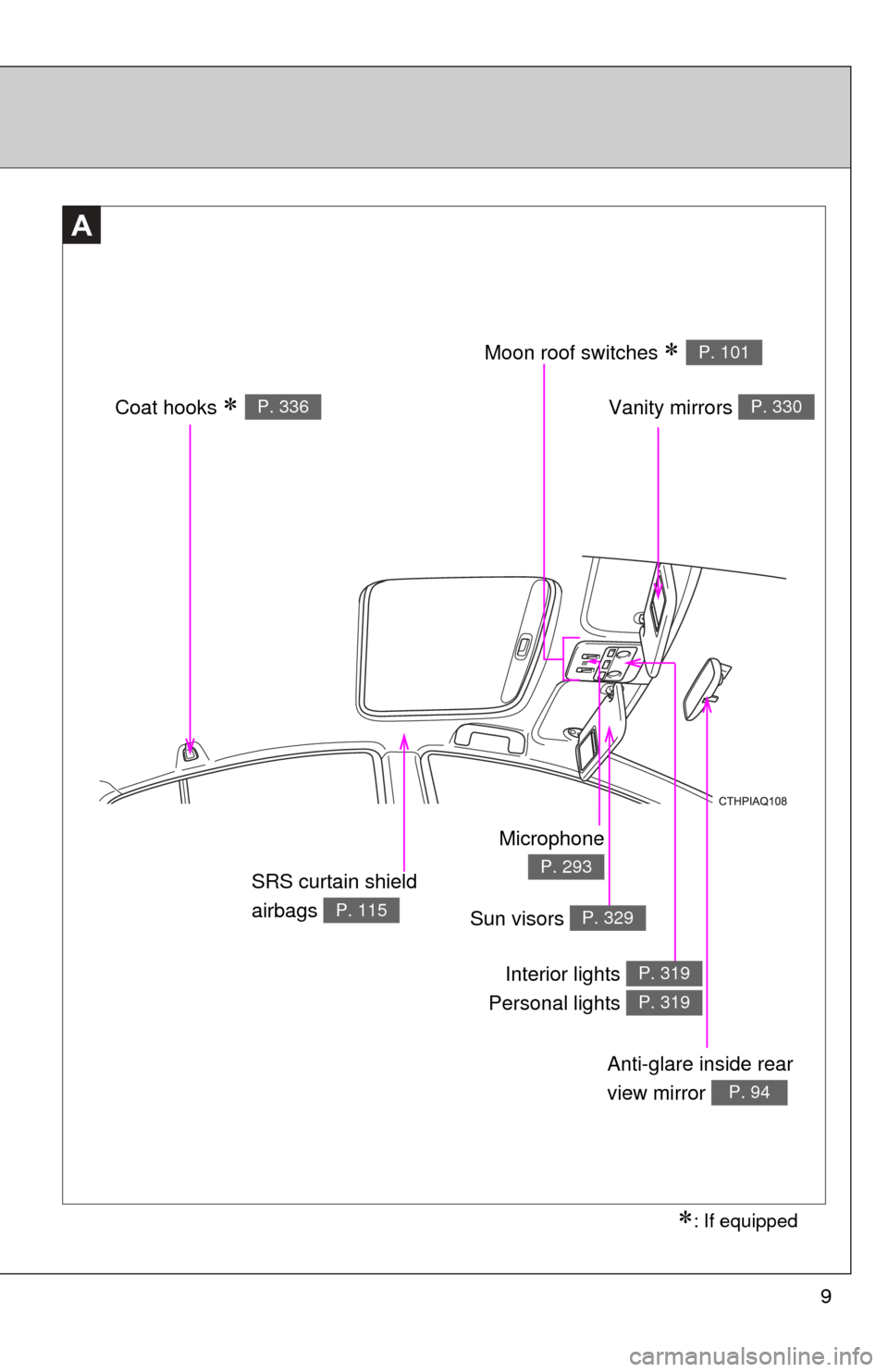
9
: If equipped
Anti-glare inside rear
view mirror
P. 94
Vanity mirrors P. 330
SRS curtain shield
airbags
P. 115
A
Moon roof switches P. 101
Sun visors P. 329
Interior lights
Personal lights P. 319
P. 319
Coat hooks P. 336
Microphone
P. 293
Page 42 of 552
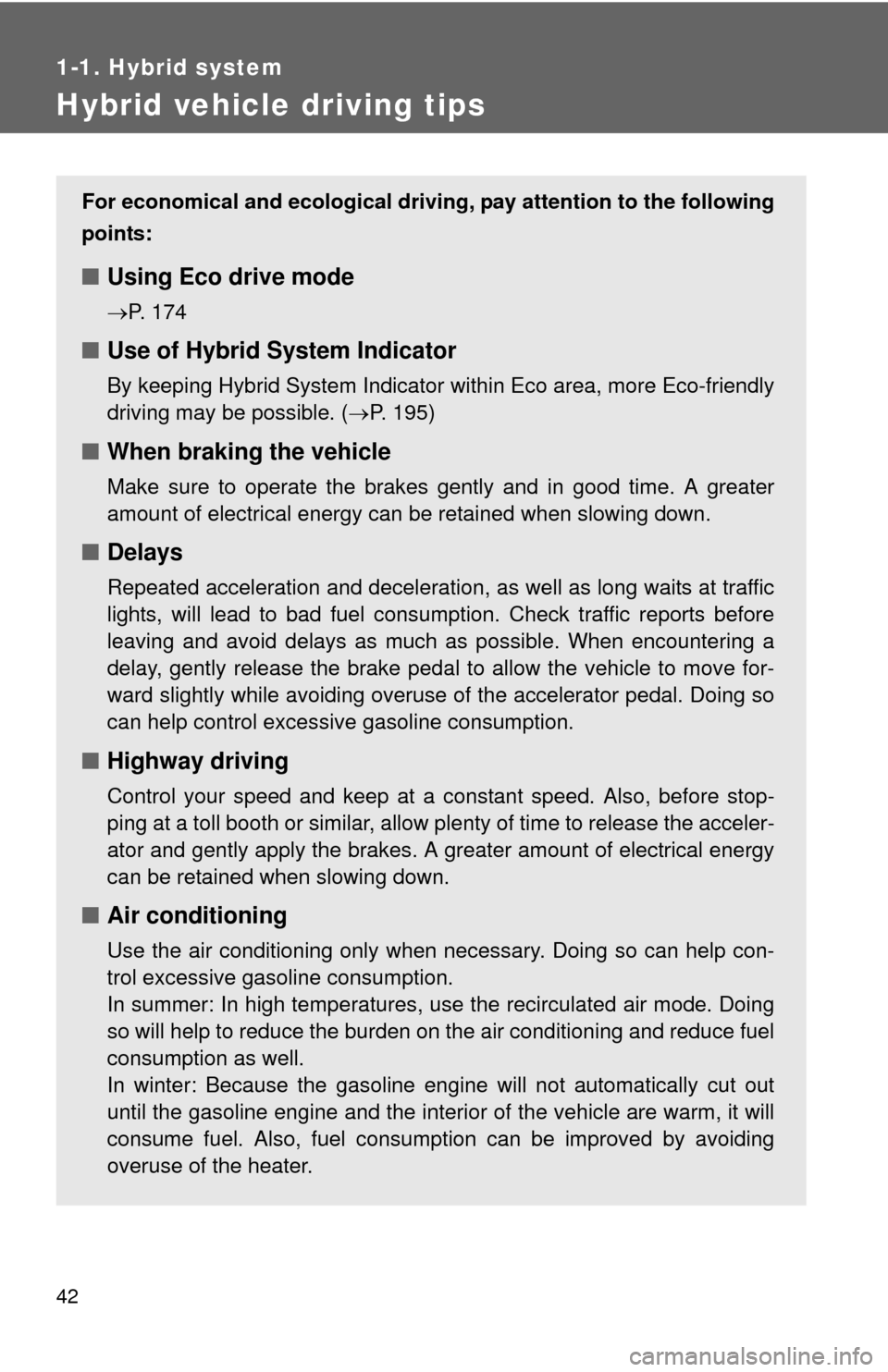
42
1-1. Hybrid system
Hybrid vehicle driving tips
For economical and ecological driving, pay attention to the following
points:
■ Using Eco drive mode
P. 174
■Use of Hybrid System Indicator
By keeping Hybrid System Indicator within Eco area, more Eco-friendly
driving may be possible. ( P. 195)
■When braking the vehicle
Make sure to operate the brakes gently and in good time. A greater
amount of electrical energy can be retained when slowing down.
■Delays
Repeated acceleration and deceleration, as well as long waits at traffic
lights, will lead to bad fuel consumption. Check traffic reports before
leaving and avoid delays as much as possible. When encountering a
delay, gently release the brake pedal to allow the vehicle to move for-
ward slightly while avoiding overuse of the accelerator pedal. Doing so
can help control excessive gasoline consumption.
■Highway driving
Control your speed and keep at a constant speed. Also, before stop-
ping at a toll booth or similar, allow plenty of time to release the acceler-
ator and gently apply the brakes. A greater amount of electrical energy
can be retained when slowing down.
■Air conditioning
Use the air conditioning only when necessary. Doing so can help con-
trol excessive gasoline consumption.
In summer: In high temperatures, use the recirculated air mode. Doing
so will help to reduce the burden on the air conditioning and reduce fuel
consumption as well.
In winter: Because the gasoline engine will not automatically cut out
until the gasoline engine and the interior of the vehicle are warm, it will
consume fuel. Also, fuel consumption can be improved by avoiding
overuse of the heater.
Page 235 of 552
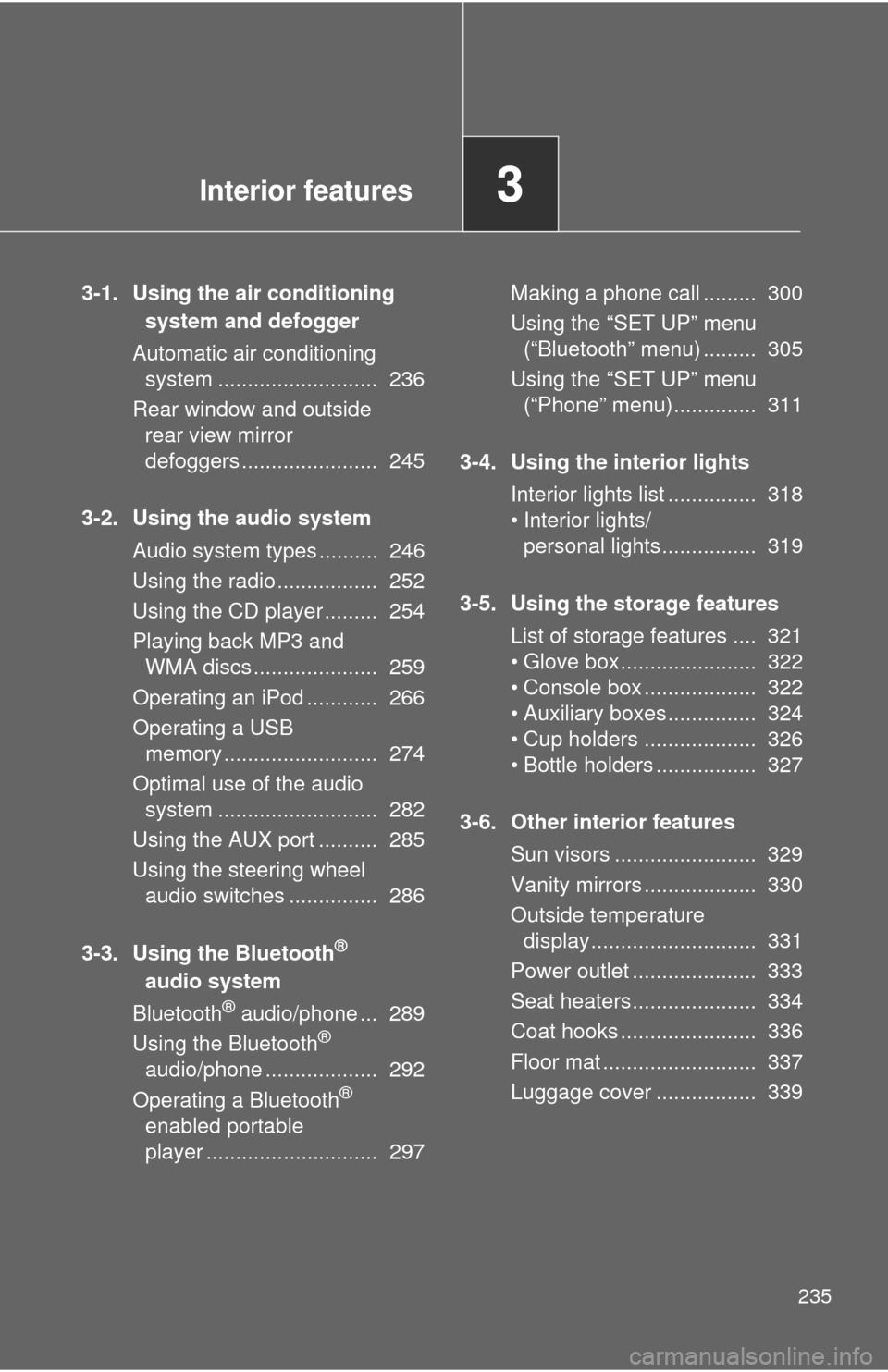
Interior features3
235
3-1. Using the air conditioningsystem a nd defogger
Automatic air conditioning system ........................... 236
Rear window and outside rear view mirror
defoggers ....................... 245
3-2. Using the audio system Audio system types .......... 246
Using the radio ................. 252
Using the CD player ......... 254
Playing back MP3 and WMA discs ..................... 259
Operating an iPod ............ 266
Operating a USB memory .......................... 274
Optimal use of the audio system ........................... 282
Using the AUX port .......... 285
Using the steering wheel audio switches ............... 286
3-3. Using the Bluetooth
®
audio system
Blu etooth
® audio/phone ... 289
Using the Bluetooth®
audio/phone ................... 292
Operating a Bluetooth
®
enabled portable
player ............................. 297 Making a phone call ......... 300
Using the “SET UP” menu
(“Bluetooth” menu) ......... 305
Using the “SET UP” menu (“Phone” menu).............. 311
3-4. Using the interior lights Interior lights list ............... 318
• Interior lights/personal lights................ 319
3-5. Using the storage features List of storage features .... 321
• Glove box....................... 322
• Console box ................... 322
• Auxiliary boxes ............... 324
• Cup holders ................... 326
• Bottle holders ................. 327
3-6. Other interior features Sun visors ........................ 329
Vanity mirrors ................... 330
Outside temperature display............................ 331
Power outlet ..................... 333
Seat heaters..................... 334
Coat hooks ....................... 336
Floor mat .......................... 337
Luggage cover ................. 339
Page 318 of 552
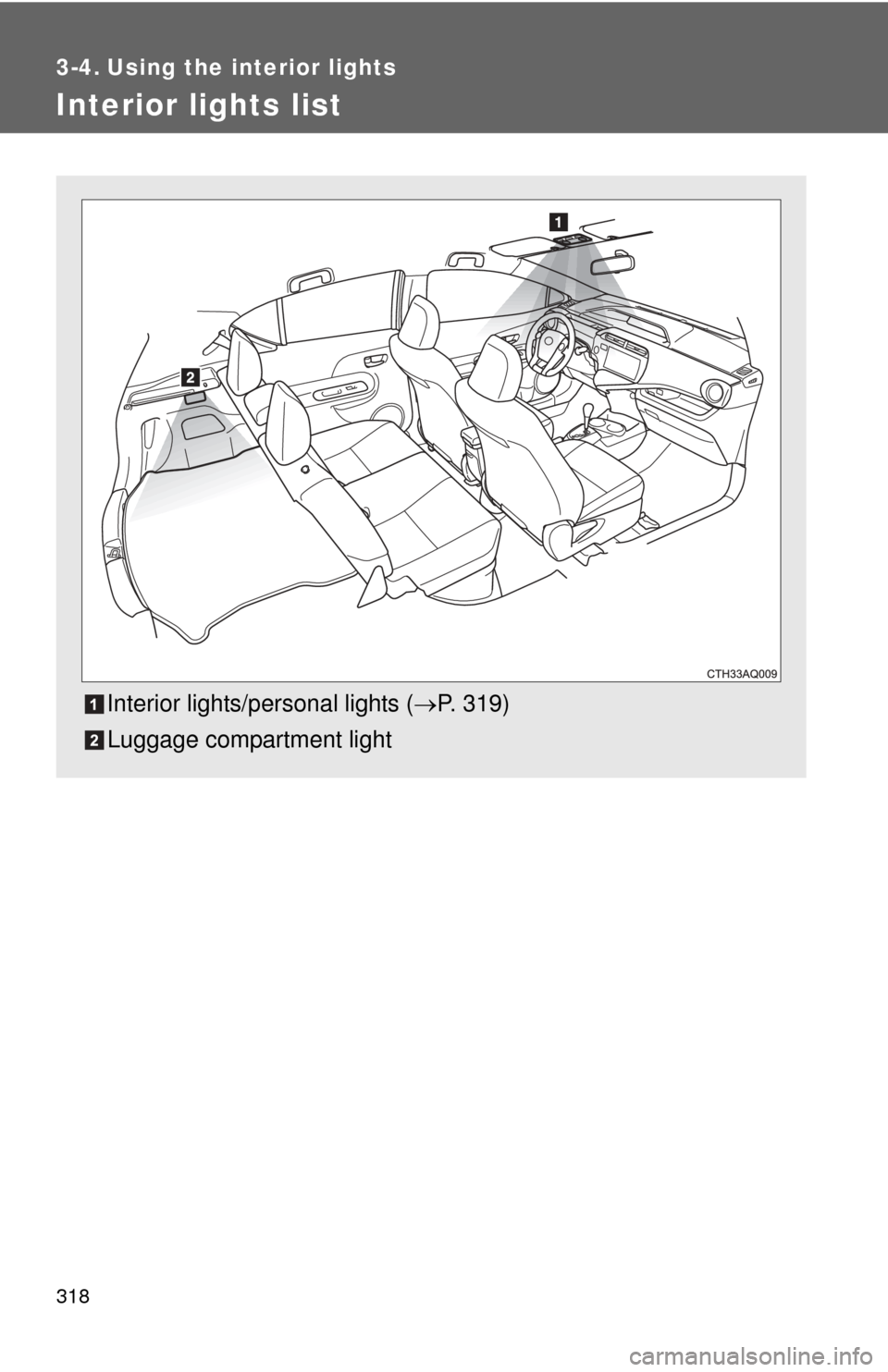
318
3-4. Using the interior lights
Interior lights list
Interior lights/personal lights (P. 319)
Luggage compartment light
Page 319 of 552
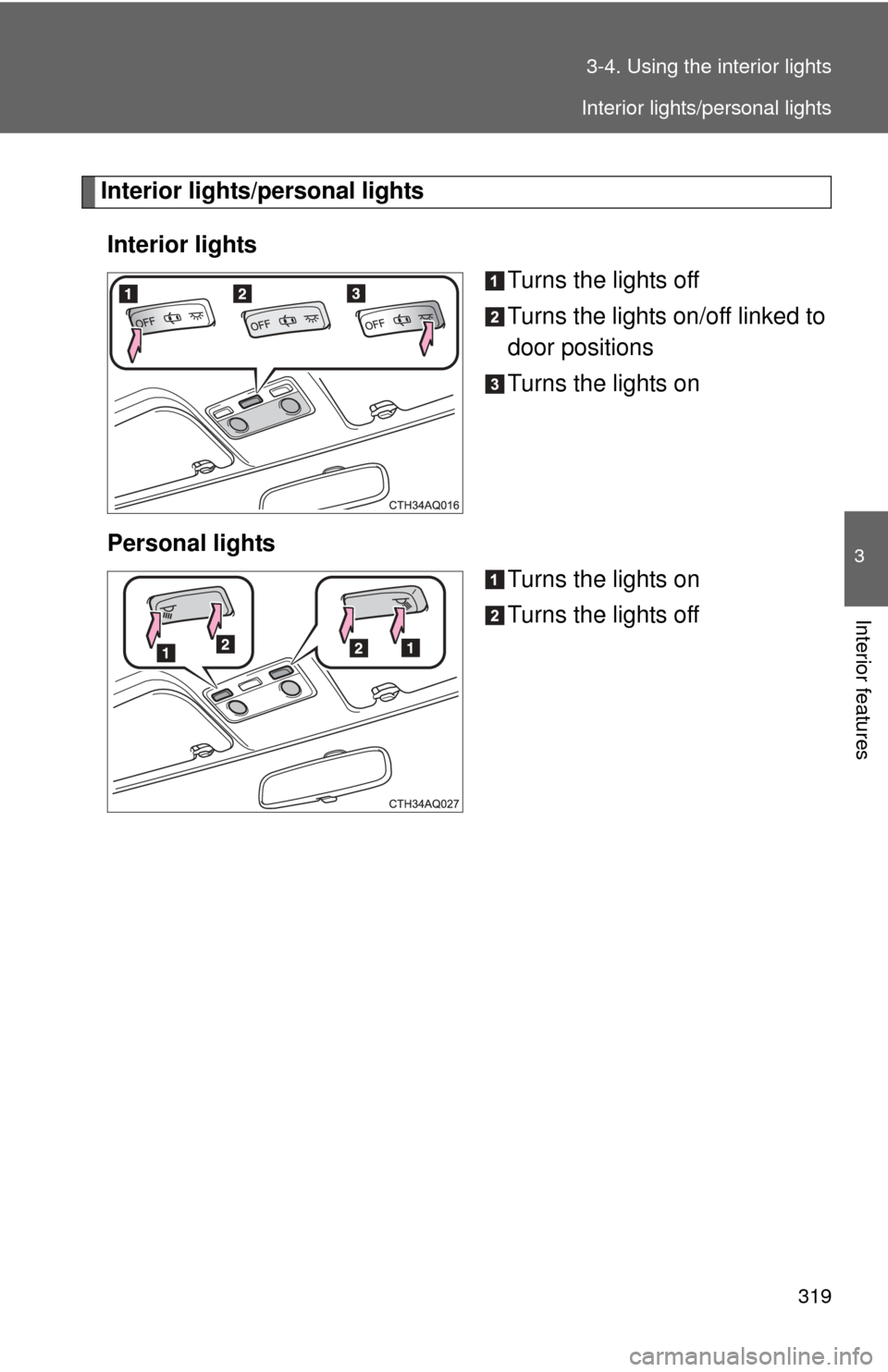
319
3-4. Using the interior lights
3
Interior features
Interior lights/personal lights
Interior lights Turns the lights off
Turns the lights on/off linked to
door positions
Turns the lights on
Personal lights Turns the lights on
Turns the lights off
Interior lights/personal lights
Page 320 of 552
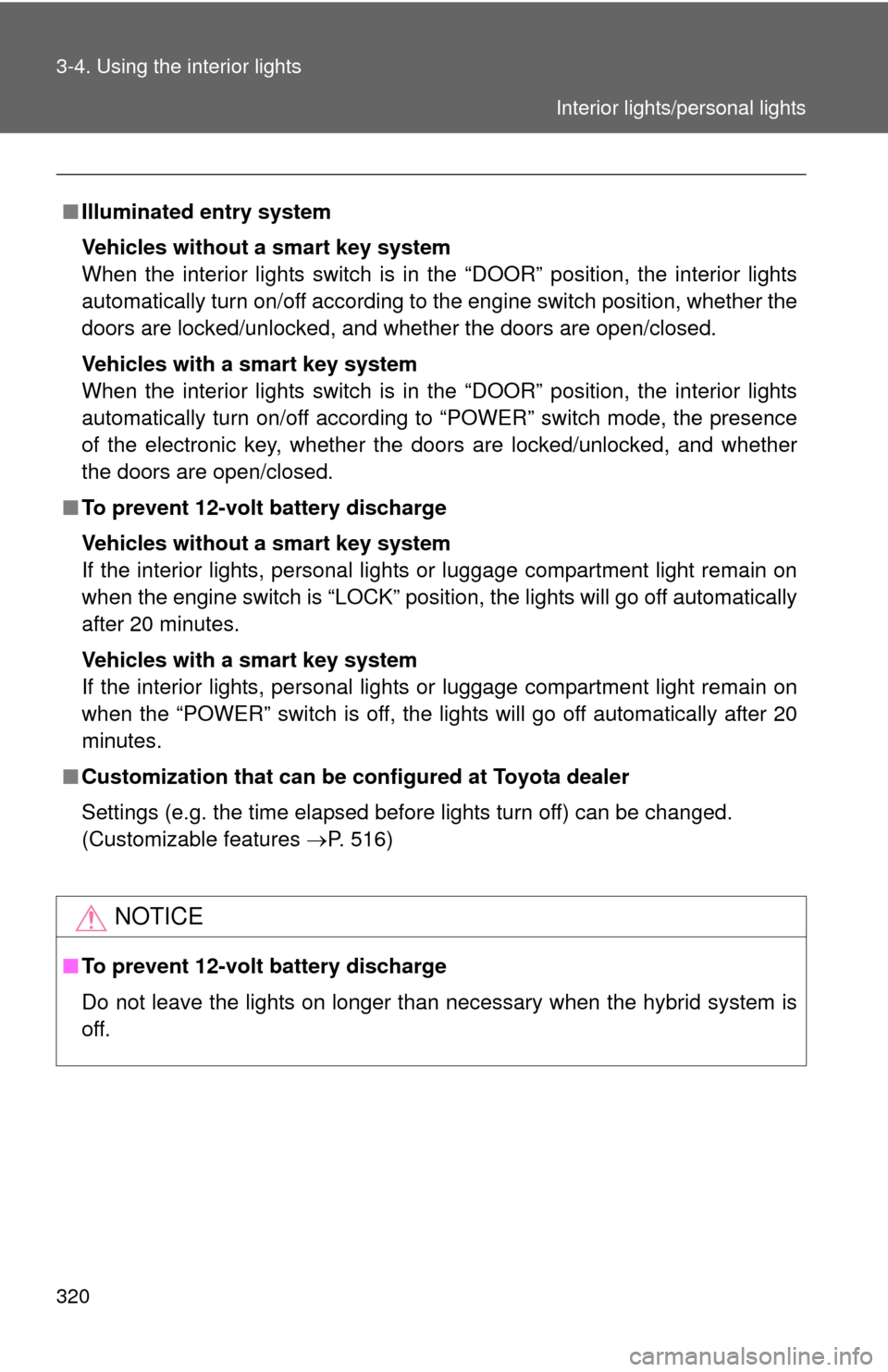
320 3-4. Using the interior lights
■Illuminated entry system
Vehicles without a smart key system
When the interior lights switch is in the “DOOR” position, the interior lights
automatically turn on/off according to the engine switch position, whether the
doors are locked/unlocked, and whether the doors are open/closed.
Vehicles with a smart key system
When the interior lights switch is in the “DOOR” position, the interior lights
automatically turn on/off according to “POWER” switch mode, the presence
of the electronic key, whether the doors are locked/unlocked, and whether
the doors are open/closed.
■ To prevent 12-volt battery discharge
Vehicles without a smart key system
If the interior lights, personal lights or luggage compartment light remain on
when the engine switch is “LOCK” position, the lights will go off automatically
after 20 minutes.
Vehicles with a smart key system
If the interior lights, personal lights or luggage compartment light remain on
when the “POWER” switch is off, the lights will go off automatically after 20
minutes.
■ Customization that can be co nfigured at Toyota dealer
Settings (e.g. the time elapsed before lights turn off) can be changed.
(Customizable features P. 516)
NOTICE
■To prevent 12-volt battery discharge
Do not leave the lights on longer than necessary when the hybrid system is
off.
Interior lights/personal lights
Page 352 of 552

352 4-2. Maintenance
Vehicle interior
ItemsCheck points
12-volt battery Check the connections. ( P. 375)
Accelerator pedal • The accelerator pedal should
move smoothly (without uneven
pedal effort or catching).
Brake pedal • Does the brake pedal move
smoothly?
• Does the brake pedal have appro- priate clearance from the floor?
(P. 497)
• Does the brake pedal have the correct amount of free play?
(P. 497)
Brakes • The vehicle should not pull to one
side when the brakes are applied.
• The brakes should work effec- tively.
• The brake pedal should not feel spongy.
• The brake pedal should not get too close to the floor when the
brakes are applied.
Head restraints
(Adjustable type) • Do the head restraints move
smoothly and lock securely?
Hybrid transmission “Park” mech-
anism • When parked on a slope and the
parking brake is on, is the vehicle
securely stopped?
Indicators/buzzers • Do the indicators and buzzers
function properly?
Lights • Do all the lights come on?
Page 469 of 552
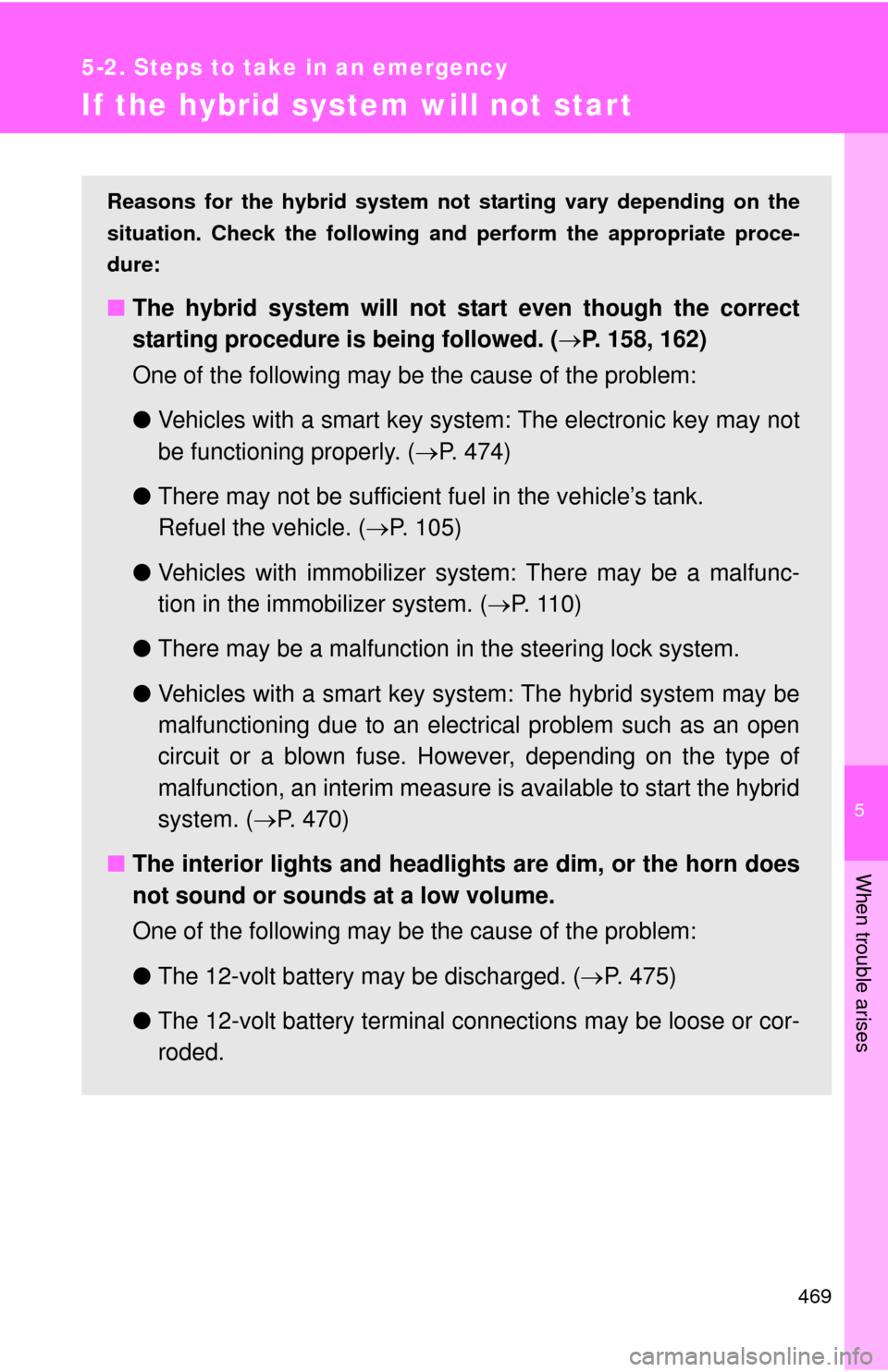
5
When trouble arises
469
5-2. Steps to take in an emergency
If the hybrid system will not start
Reasons for the hybrid system not starting vary depending on the
situation. Check the following and perform the appropriate proce-
dure:
■ The hybrid system will not start even though the correct
starting procedure is being followed. ( P. 158, 162)
One of the following may be the cause of the problem:
● Vehicles with a smart key system: The electronic key may not
be functioning properly. ( P. 474)
● There may not be sufficient fuel in the vehicle’s tank.
Refuel the vehicle. ( P. 105)
● Vehicles with immobilizer sy stem: There may be a malfunc-
tion in the immobilizer system. ( P. 1 1 0 )
● There may be a malfunction in the steering lock system.
● Vehicles with a smart key syst em: The hybrid system may be
malfunctioning due to an electrical problem such as an open
circuit or a blown fuse. However, depending on the type of
malfunction, an interim measure is available to start the hybrid
system. ( P. 470)
■ The interior lights and headlights are dim, or the horn does
not sound or sounds at a low volume.
One of the following may be the cause of the problem:
●The 12-volt battery may be discharged. ( P. 475)
● The 12-volt battery terminal c onnections may be loose or cor-
roded.
Page 470 of 552
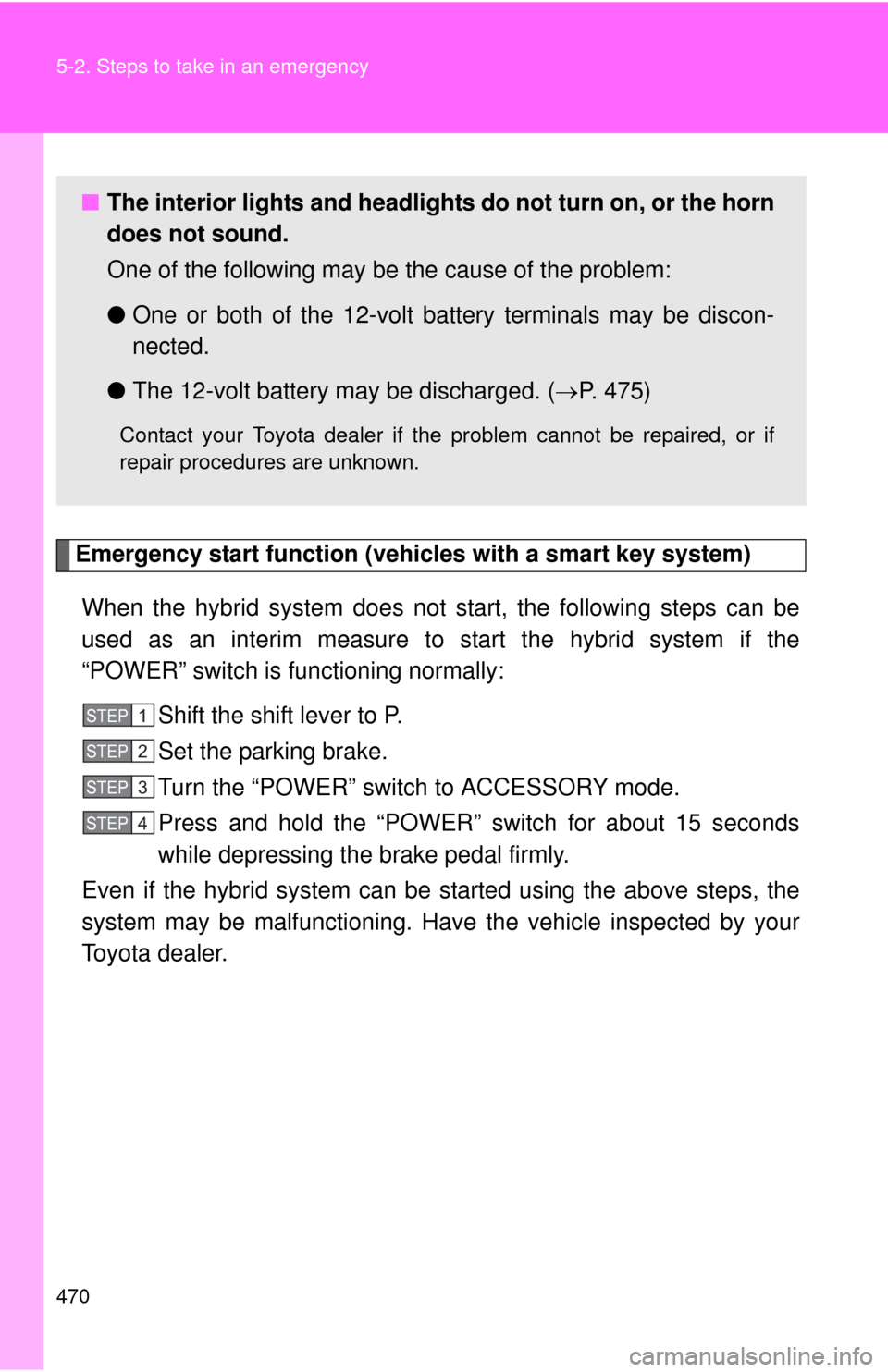
470 5-2. Steps to take in an emergency
Emergency start function (vehicles with a smart key system)When the hybrid system does not start, the following steps can be
used as an interim measure to start the hybrid system if the
“POWER” switch is functioning normally: Shift the shift lever to P.
Set the parking brake.
Turn the “POWER” switch to ACCESSORY mode.
Press and hold the “POWER” switch for about 15 seconds
while depressing the brake pedal firmly.
Even if the hybrid system can be started using the above steps, the
system may be malfunctioning. Have the vehicle inspected by your
Toyota dealer.
■ The interior lights and headlights do not turn on, or the horn
does not sound.
One of the following may be the cause of the problem:
●One or both of the 12-volt ba ttery terminals may be discon-
nected.
● The 12-volt battery may be discharged. ( P. 475)
Contact your Toyota dealer if the problem cannot be repaired, or if
repair procedures are unknown.
STEP1
STEP2
STEP3
STEP4